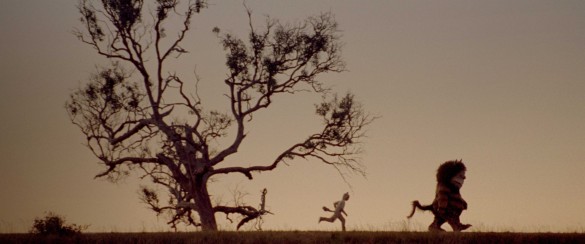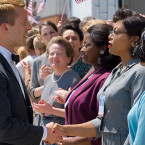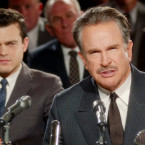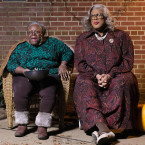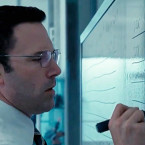News & Notes Inside the Week in Film
Mo Boobs, Mo Problems
Sometimes going to Comic-Con and walking around with three breasts can cause problems. Actress Kaitlyn Leeb learned this the hard way.
 by Kevin Withers
by Kevin Withers
There were a lot of memorable scenes in the original Total Recall; Arnold Schwarzenegger pulling a large, glowing orb from his nose, people’s eyes popping out of their heads, the line “two weeks” repeated ad naseum by an incredibly fat woman and the secretary at Rekall painting her nails by simply tapping them. However, there was one image that was far more memorable than the aforementioned few: that of Mary, the prostitute.
I always knew there was some reason that my father would send me out of the room during Total Recall’s bar scene (he did the same thing for the hotel room scene in True Lies). Once I was old enough to watch the movie on my own, I was finally able to see what my father had been hiding from me all these years: Mary’s boobs. All three of them.
Thanks to a faulty oxygen regulation system on Mars, numerous people had developed mutations. As one of these mutants, Mary had grown a third breast. In her line of work as a prostitute, this helped her immeasurably. After seeing her for the first time, one of the film’s supporting cast members waxed philosophically, “Baby, you make me wish I had three hands.”
Quote
“There, there. You had no way of knowing the man you were dating was a vicious, murdering sociopath.”
-Leslie Nielsen offers sympathy to a distraught woman in The Naked Gun 2 1/2
When news of a Total Recall remake came out, I wondered the question I’m sure a lot of people were wondering, would they include Mary? The answer to that is an emphatic yes. Kaitlyn Leeb was cast as Mary (and now shows up in the credits as the ‘three-breasted woman’, lest hookers everywhere be offended). Promoting the film at 2012’s Comic-con, Leeb made quite the impression as she strutted around in full three-boob make up. And, really, what could go wrong with an exceptionally good-looking actress thrusting herself into ground zero of horny sci-fi nerds outfitted with three photo-realistic breasts? Oh, yes! Everything!
Leeb drew far more attention than she could handle and was, judging from her comments about the situation, completely shocked by this turn of events. She told the Calgary Herald, “There were a bunch of people at Comic-Con asking if I had surgery for the third [breast]… I guess that’s the thing that bothers me the most is that they think I’m out there prancing around Comic-Con with my breasts out. They really are not mine!”
Setting aside the fact that some people apparently think that there’s a society of three-breasted woman roaming around, I’m not sure what surprises me more: that Leeb thought that people wouldn’t comment on her three-breasted makeup or that she seemingly expected people to talk to her about something else. Perhaps how she prepared for her roles in Wrong Turn 4 or Locked Down, I suppose.
Leeb did, however, learn a lesson from her misadventures at Comic-Con, stating of her upcoming film choices, “I guess I have to be careful with the next roles that would come up, you don’t want to get typecast.”
Hear that Hollywood? You’re just going to have to find someone else to fill all those three-breasted, mutant hooker roles out there.
The Question of the Month:
Why is Seinfeld released to DVD by Sony?
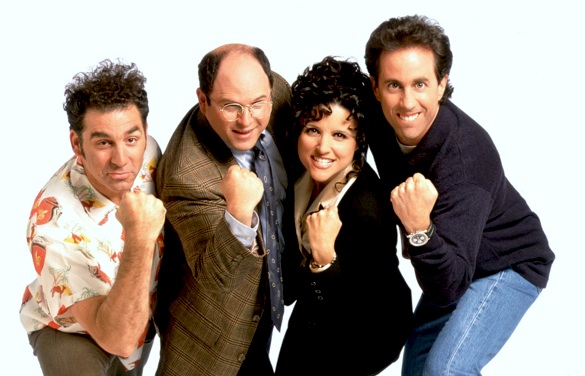 by Chris Neumer
by Chris Neumer
THE QUESTION: I’ve never understood this. Seinfeld was originally broadcast on NBC, which is owned by Universal. Why is it released to DVD by Sony? How does this work? Lou I. (via e-mail)
THE ANSWER: The question is even more quizzical than it initially appears because after some cursory digging, I realized that not only was Seinfeld broadcast on the Universal owned NBC, but it was produced by Castle Rock Entertainment, a company that is owned by Warner Brothers and it was shot at the Viacom (read: Paramount) owned CBS studios. Yup, it’s true, NBC’s biggest television hit ever was filmed on its rival’s lot.
Attempting to understand why certain television shows are released to DVD by different studios is a headache inducing exercise to be sure, but it all has to do with who owns the distribution rights to a given show.
Sometimes, everything seems to work out okay: Fox Television’s critically acclaimed series’ Arrested Development, The Family Guy and The Simpsons are all released to DVD by Fox. Fox also releases its F/X subsidiary’s The Shield and It’s Always Sunny in Philadelphia. Things start to get a little confusing though when you realize that shows that are broadcast on Fox and F/X (like Rescue Me, for example) end up released on DVD by other studios (like Sony, for example).
To best figure out how this DVD releasing system works for television shows–and specifically for Seinfeld–one needs to ask more pointed question: why does Sony own the distribution rights to Seinfeld? The answer to that, while slightly confusing, explains all.
First some history. When Rob Reiner, Alan Horn, Martin Shafer and two other partners formed Castle Rock Entertainment in 1987, they did so with Columbia Pictures as a “strategic partner”. Though the exact definition of what strategic partner means is up for interpretation, my best guess is that Columbia ponied up some start-up cash in return for a first look distribution deal with Castle Rock and a percentage of their profits.
In 1989, Castle Rock decided to take a stab at television production and wound up producing an esoteric sit-com about nothing called Seinfeld. As far as I can tell, Seinfeld was Castle Rock’s only successful entry into the world of television production. After Seinfeld, Castle Rock only produced a handful of truly dreadful shows including The Single Guy, The Michael Richards Show, something called Bliss (?) and Reunited (?).
Castle Rock Entertainment and Castle Rock Television were then bought out by Time-Warner in 1994, a transaction that gave Warner Brothers Television the actual rights to the Seinfeld show. However, thanks to a distribution and syndication deal that Castle Rock had signed with Columbia-Tristar prior to the Time-Warner sale, Columbia-Tristar owned the home video and syndication rights to the show. When Sony purchased Columbia-Tristar, these distribution and syndication rights transferred over to Sony, hence the fact they are releasing the show onto DVD.
If it seems a little confusing, it’s because it is. So confusing, in fact, that not even the studios themselves are exactly sure what’s going on. In an article in TVWeek, representatives for both Warner Brothers and Sony said that the responsibility for enforcing the copyright for Seinfeld fell into the lap of the other company.
Performance Spotlight On:
John Turturro in Anger Management
by Chris Neumer
 I hesitate to call John Turturro a character actor since that designation usually refers more to a given actor’s supporting standing than anything else. After screening Anger Management though, one thing becomes very apparent, Turturro is probably the best actor in the business when it comes to creating nuanced and finely tuned supporting characters.
I hesitate to call John Turturro a character actor since that designation usually refers more to a given actor’s supporting standing than anything else. After screening Anger Management though, one thing becomes very apparent, Turturro is probably the best actor in the business when it comes to creating nuanced and finely tuned supporting characters.
In Anger Management, Turturro plays Chuck, a fellow rage-aholic in group therapy with Dave Buznik (Adam Sandler). In the script, there isn’t much depth to the role of Chuck. Hell, outside of three or four scenes, Chuck isn’t even in the movie. And yet like Turturro’s Jesus Quintana in The Big Lebowski, audience members leave the theatres desperately wanting more of Turturro.Turturro’s knack for creating these extremely odd-ball characters comes with his ability to deliver completely over-the-top dialogue believably, without ever giving off the sense that he is in on the joke.
When confronting Sandler during a group therapy meeting, Turturro weaves back and forth in front of the cowed star before finally erupting with the outburst, “What? Do you think you’re better than me because you’ve got both nuts?” Dead serious, Turturro barely allows viewers time to laugh at the stupidity of the statement (and to question what, exactly, might have happened) before he is onto another rant.Friends on-screen with the flamboyant Lou (Luis Guzman), we learn through a bout of insults that Chuck has also managed to impregnate an aunt of his. And it fits. That’s just the kind of character that Turturro has created in Chuck. Which is truly saying something.
Every now and then the audience gets a peek into how truly solid of an actor Turturro really is (and can be in straight roles). While at a bar with Buznik, Chuck is actually content to sit back and deliver semi-realistic dialogue with his new anger-ally friend. Of course, then Chuck picks a fight with a blind man, but the viewer has gotten that glimpse. Nobody does these roles better than Turturro.
The Photo of the Week
Where the Wild Things Are
The 5 Things I Learned This Week
Fascinatingly true things to broaden your mind
1) It was predicted that summit of Mount Shasta (California) would receive 218 inches of snow during the 4-day time period from December 6, 2012 – December 9, 2012.
2) The most snow ever recorded in one snowstorm is also at Mount Shasta. It got 189 inches of snow in February of 1959.
3) Mount Shasta was originally called Strawberry Valley. Then Berryvale. Then Sisson. Then Mount Shasta City. Finally, it dropped the ‘City’ and is now known as simply Mount Shasta.
4) The record for snowfall in Mount Shasta for a season is 349.6 inches. And this didn’t happen when it got the 189 inches of snow in one snowstorm. It happened seven years earlier, in 1952.
5) It snows in Atlanta. Not much–almost 39 inches total in the last 23 years–but it does snow there.
This Week’s Stories
- Why Having Three Boobs is Problematic
- The Seinfeld Mystery
- Performace Spotlight On: John Turturro
- The Photo of the Week
- Trivial Fascinations: The Five Things I Learned This Week
New Releases
Pitch Perfect
 THE PLAYERS: Starring Anna Kendrick, Brittany Snow, and Rebel Wilson; written by Kay Cannon; directed by Jason Moore; Released by Universal. Rated PG-13.
THE PLAYERS: Starring Anna Kendrick, Brittany Snow, and Rebel Wilson; written by Kay Cannon; directed by Jason Moore; Released by Universal. Rated PG-13.
THE PLOT: A college freshman joins an all girls A Capella group to face off against an all boys group in a competition.
THE SKINNY:
– Not to be confused with the Clint Eastwood movie, Trouble with the Curve. Also, it’s not about baseball. Nor does it involve Jennifer Aniston or Jay Mohr.
+ Fills that cultural need we had for an a cappella movie.
+/- It’s interesting to consider what lead Anna Kendrick’s has accomplished here. In 2009, Kendrick appeared in Up in the Air as a just-graduated-from-college employee of a huge company. Three years have passed and now Kendrick is playing a disinterested student three months beyond her high school graduation.
– I’d call this Bring it On with a cappella groups, but that doesn’t quite capture the gravity of how accurate a description that actually is. I would bet large sums of money that the working title of this film was Sing it On. Oh, yeah, I went there.
– There is nowhere near enough sex and debauchery in this film to truly represent the hedonistic party lifestyle of real a cappella groups. Real a cappella groups are like Caligula’s court meets Studio 54 with a clique that the jocks throw pennies at.
YES, IT’S TRUE: “A capella” literally translates to “in the style of the chapel”.
Total Recall
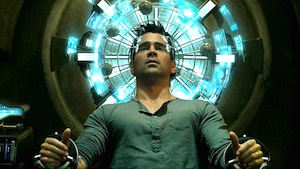 THE PLAYERS: Starring Colin Farrell, Kate Beckinsale, and Jessica Biel; written by Kurt Wimmer and Mark Bomback; directed by Len Wiseman. Released by Sony Pictures. Rated PG-13.
THE PLAYERS: Starring Colin Farrell, Kate Beckinsale, and Jessica Biel; written by Kurt Wimmer and Mark Bomback; directed by Len Wiseman. Released by Sony Pictures. Rated PG-13.
THE PLOT: A man believes he is a secret agent after he visits a company that specializes in fake memory implants.
THE SKINNY:
– This is a minor point, but this film’s poster is horrible. It’s almost like Colin Farrell got in the way of someone doing graphic design on a deadline.
– I always found this to be a strange choice of a movie to remake. There’s generally a purpose that accompanies any type of filmmaking—why are you making this movie?—and, no matter how many times I think about it, I can’t figure out why the powers-that-be looked at the original Total Recall and thought, “Yeah, we should remake this.” The original film, while a tad small in scope thanks to the limitations of 1990’s computer generated images, is an effective thriller with decent action sequences and a stellar score courtesy of Jerry Goldsmith. It didn’t have any glaring plot holes in it, was strangely thought provoking for an Arnold Schwarzenegger film and also one of the best adaptations of a Phillip K. Dick story out there. In short, as far as I can see, there weren’t any really good reasons to remake the film. If someone honestly looked at the original and thought, “They’ve got something here… and I think I can do it better,” I’d be fine with it. However, that isn’t what happened here.
YES, IT’S TRUE: Eleven movies have been made that are based off of Phillip K Dick’s work, including Minority Report, Blade Runner, and Paycheck.
Trouble With the Curve
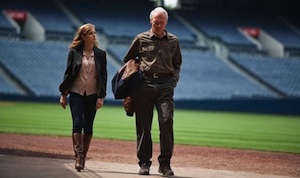 THE PLAYERS: Starring Clint Eastwood, Amy Adams, and John Goodman; written by Randy Brown; directed by Robert Lorenz. Released by Warner Bros. Rated PG-13.
THE PLAYERS: Starring Clint Eastwood, Amy Adams, and John Goodman; written by Randy Brown; directed by Robert Lorenz. Released by Warner Bros. Rated PG-13.
THE PLOT: A baseball scout on the verge of retirement bonds with his daughter when she joins him on his final scouting trip.
THE SKINNY:
– I’m a huge connoisseur of both advanced baseball statistics and box office numbers. I love the added perspective numbers give to sports and entertainment. Whenever I encounter people who dismiss their importance, I instantly look to stop talking to them. Why talk to people who aren’t interested in more information about the very things that they purport to be interested in?
– One of the subplots of this film is that Eastwood’s character is losing his eyesight. Yes, he is a baseball scout who can’t see. Oh, yeah, and he doesn’t believe in numbers either. This either explains a lot about the Atlanta Braves’ farm system or shows that Eastwood is a master at using his ears to figure out whether kids can play ball.
– Amy Adams is sneaky old. I assumed she was 29 or 30. However, she’s not, she’s 38. Old enough that I could legitimately make the statement: Amy Adams is middle-aged. What. The. Fuck? (It’s still weird though to consider that she’s Eastwood on-screen daughter. It looks like there’s a solid 55 years between the two).
– Like For Love of the Game, I feel as though there is a pretty glaringly absent ‘the’ in the title here. It’s not The Trouble with the Curve, it’s simply Trouble with the Curve.
– We get to see Eastwood throw a baseball. Not pretty. It’s not Tim Robbins in Bull Durham bad, but it’s still ugly enough to merit the question: how does someone as badass as Eastwood look this uncomfortable throwing a baseball?
YES, IT’S TRUE: This is the first film Eastwood has been in that he has not directed since In the Line of Fire (1993).
Premium Rush
 THE PLAYERS: Starring Joseph Gordon-Levitt, Dania Ramirez, and Michael Shannon; written by David Koepp and John Kamps, directed by David Koepp. Released by Sony Pictures. Rated PG-13.
THE PLAYERS: Starring Joseph Gordon-Levitt, Dania Ramirez, and Michael Shannon; written by David Koepp and John Kamps, directed by David Koepp. Released by Sony Pictures. Rated PG-13.
THE PLOT: A bike courier runs from a crooked police officer who is after the package he carries.
THE SKINNY:
+ I can’t highlight enough the success of Joseph Gordon-Levitt. He is one the very few actors who successively broke out of his teen years in 3rd Rock From the Sun and 10 Things I Hate About You to become a damn good supporting action star in Inception and The Dark Knight Rises. Now he has taken on the role of leading man in films like 50/50, Looper, and Premium Rush, all the while remaining as charming as he is bad ass.
– I can never help but roll my eyes when Hollywood tries to make occupations look flashy. What’s next? A delivery boy carrying a pizza-bomb on a moped?
– It’s annoying when flashy titles try to sell me without telling me anything about the movie. Am I guaranteed a premium rush while watching this? What if my body is only capable of handling a regular unleaded rush?
+/- Don’t you love when you’re watching an action film and the hero simultaneously runs from the villain and the police in a high speed, um, bike chase? At least it’s something different.
+ Writer David Koepp has had a remarkable career to say the least. He is responsible for writing stories or screenplays for films such as Jurassic Park, Carlitos Way, Mission Impossible, Spider-Man (Toby Mcguire not Andrew Garfield), the list goes on. No really, it does…
YES, IT’S TRUE: In 1817, Karl von Drais invented a two wheeled machines in which a person could propel themselves by using their feet. The draisine, as he called it, later led to the invention of the first bicycle.
The New Releases were written by Chris Neumer and Kevin Withers
Columns |
Columns |
Columns |
Columns |
Columns |
Columns |
Columns |
Columns |
Columns |
Columns |
Columns |
Columns |
